British Guiana, 1871. In a small village near Georgetown, a boy was born with no arms and no legs (only a head, torso, and a short, tapering lower body). The midwife reportedly fainted. The local doctor had no medical explanation. His parents, simple Hindu farmers, named him Randyan and took him home.
They expected him to die. He decided to live better than most people ever do.

By the time he was five, Randyan had taught himself to move with a fluid, undulating motion that earned him two lifelong nicknames: “The Snake” and “The Living Torso.” Children ran after him in awe; adults crossed themselves or dropped coins. He ignored both reactions. He was too busy mastering the world on his own terms.
He learned to write by holding a pen in his mouth. He learned to draw delicate portraits the same way. He taught himself to roll a cigarette using only his lips and tongue, strike a match on the floor with a flick of his head, and light it in one smooth motion that left onlookers speechless. He spoke English with a crisp British accent, German like a Berlin professor, French like a Parisian poet, and Hindi like the storyteller his mother had been.
At eighteen he left Guiana with a traveling carnival and never looked back. By the 1890s he was a headliner on Coney Island: Prince Randian, the Human Caterpillar, dressed in a custom woolen “sock-suit” sewn by his wife (a quiet Guyanese woman named Mary who saw past the body everyone else stared at). Together they had four children, all born with arms and legs, all raised to believe their father was the strongest man on earth because he had to be.
In 1932, MGM came calling.
Director Tod Browning was making Freaks, a film that would be banned in countries for decades because it dared to show real sideshow performers as human beings. Prince Randian, now 61 years old, stole every scene he was in. The most famous sequence has no dialogue: dressed in his wool suit, he calmly rolls a cigarette, lights it, and smokes it (all with his mouth) while the camera lingers in stunned silence. Audiences gasped. Some fainted. The scene still feels like quiet rebellion nearly a century later.
Off-screen he was gentle, witty, and fiercely private. He read newspapers in four languages, argued politics with reporters, and never allowed anyone to help him dress or eat unless he chose it. When a journalist once asked how he managed marriage and fatherhood, Randian smiled and answered in perfect English:
“Love doesn’t need hands to hold it.”
He died in 1934 at the age of sixty-three, in a small apartment in New York City, surrounded by his wife and children. The cause was simply recorded as “heart failure,” as if the heart that had carried him through everything finally decided it had done enough.
The world moved on quickly. Sideshows faded, Freaks was locked away for years, and Prince Randian’s name slipped into footnotes.
But watch that 1932 cigarette scene again, really watch it, and you’ll see something timeless: a man who refused to be less than whole, proving with every small, deliberate motion that the human spirit has no limbs to lose.
Prince Randian didn’t overcome his body. He outlived everyone who ever pitied it.





